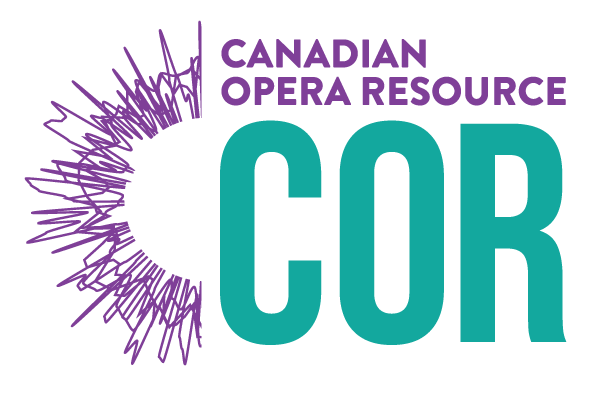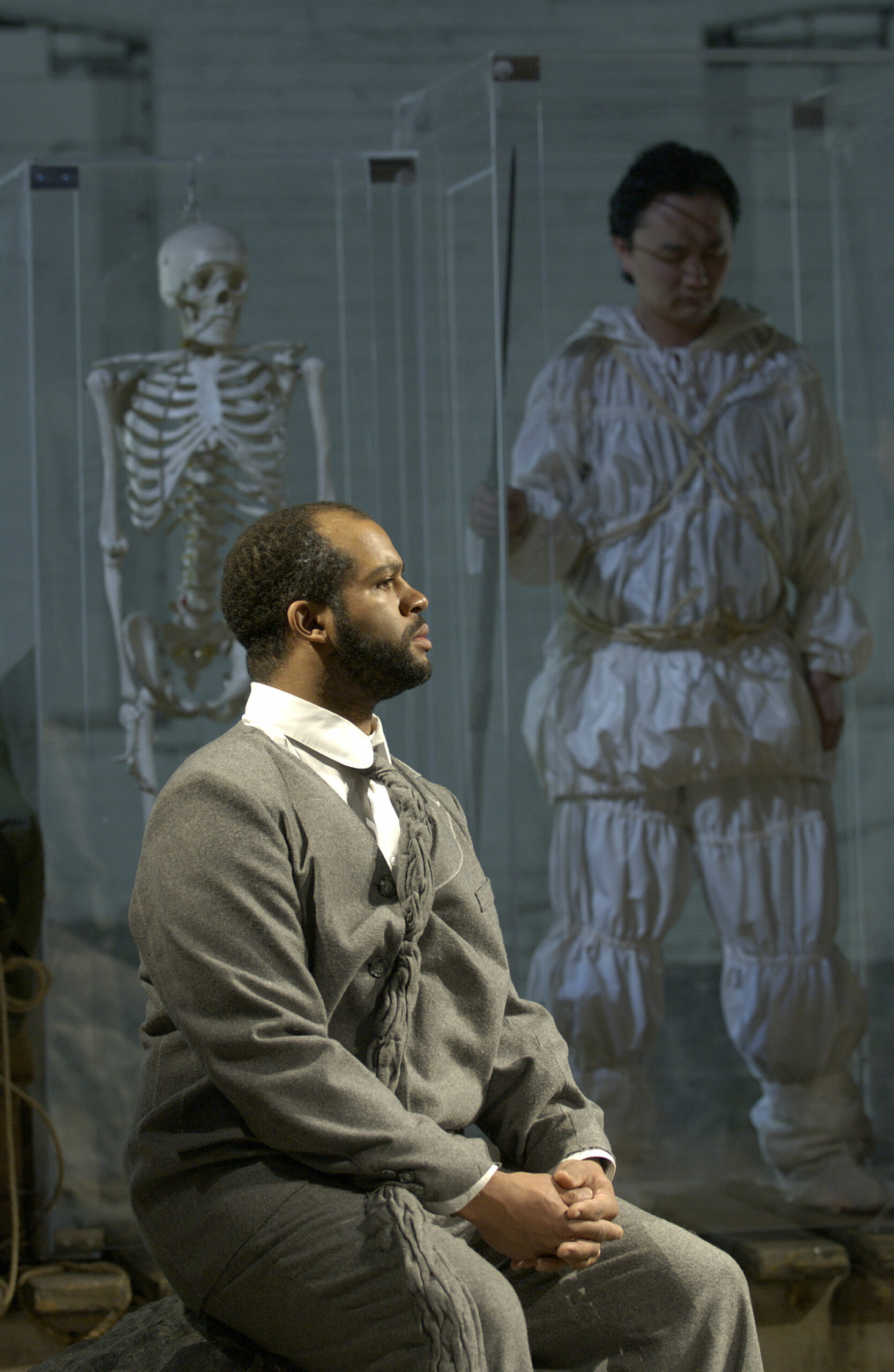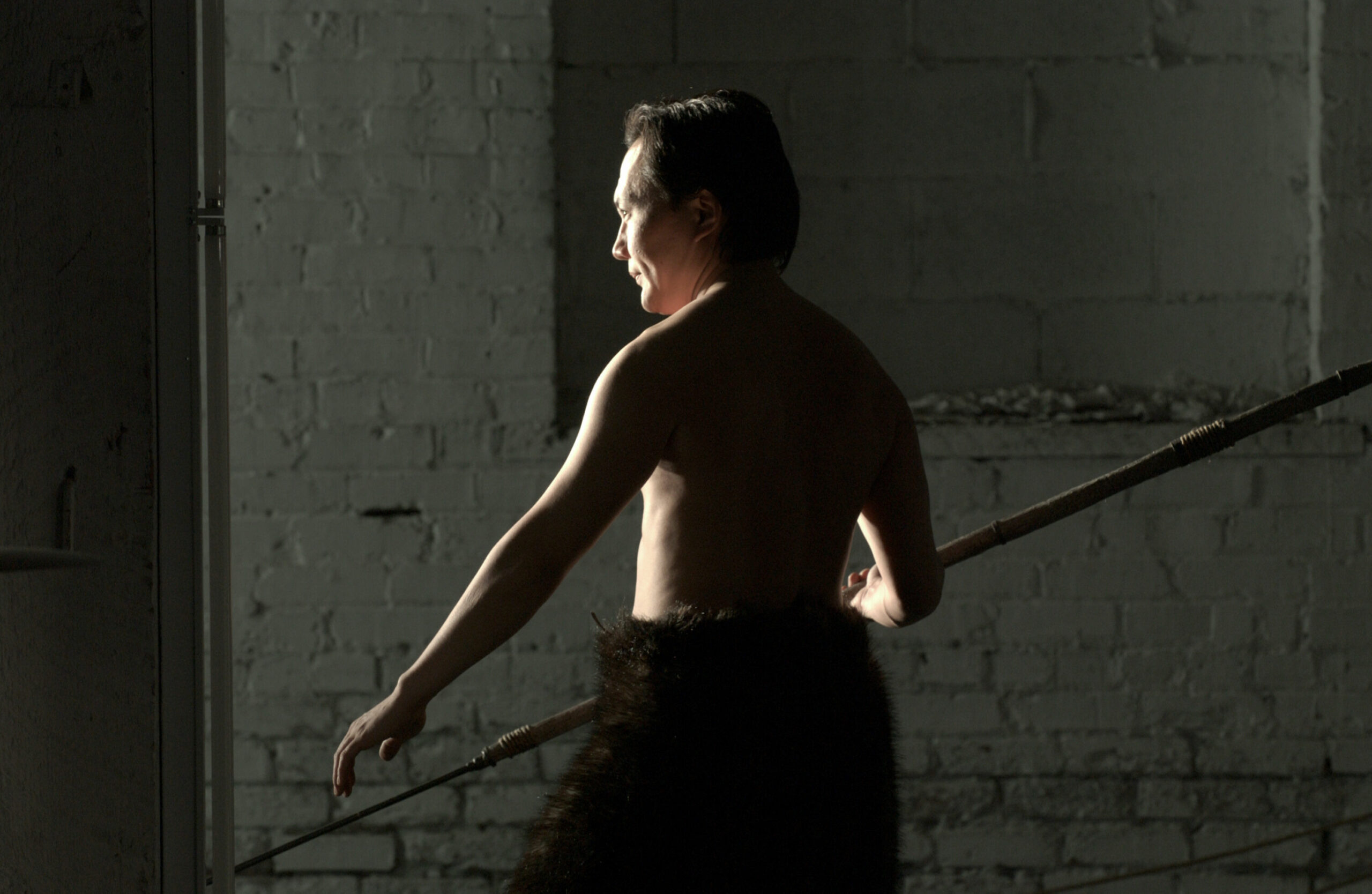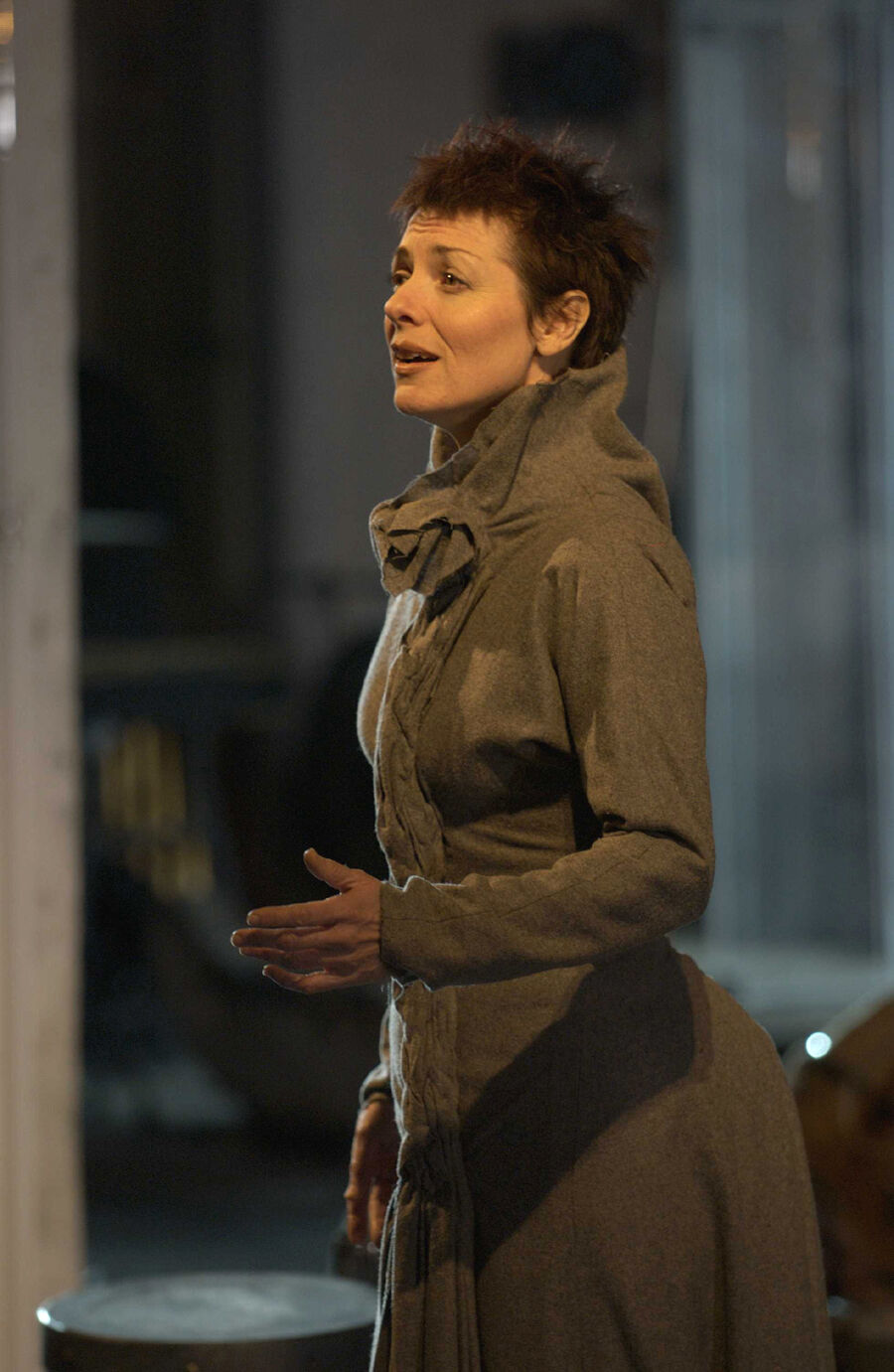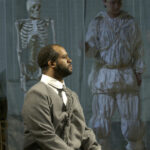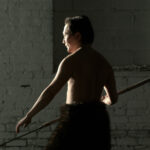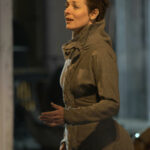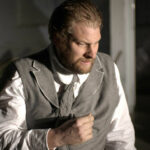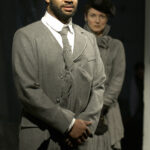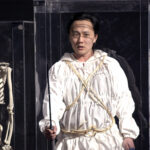View more photos below - click here
OVERVIEW
| Role | Voice Type | Range ? | Character Description |
|---|---|---|---|
| Minik | middle | D3-A4 | The youngest Inuk |
| Peary | middle-low | Bb2-F4 | American arctic explorer |
| Henson | low | Eb2-E4 | Expeditioner and Guide |
| Josephine | middle-high | F3-F5 | Peary's wife and advocate |
| The Voice | high | Bb3-A5 | Trio of 3 sopranos in the orchestra |
SYNOPSIS
Facing South is inspired by the life story of American Arctic explorer, Rear Admiral Robert Edwin Peary, and his contested discovery of the North Pole in 1909. The opera takes place in the inner landscape of Peary’s mind during the last hours of his life in February 1920, as he lies dying of pernicious anaemia and thwarted ambition on his ox skin rug in his home on Eagle Island. At the same time, in the basement of the Museum of Natural History in New York City, Peary’s wife and advocate, Josephine, asks her husband’s longtime companion and manservant, explorer Mathew Henson, to help save her husband who is losing his grip on reality.
In ten scenes, Facing South shifts between Greenland, the North Pole and the New York Museum where three generations of Greenland Inuit – “living human specimens” – were exhibited to finance Peary’s next Polar expedition. Minik, the youngest Inuk, is the only survivor. Adopted by a museum employee and public school educated, the teenage Minik discovers his father’s skeleton on display at the museum.
The opera bears witness to the true cost of the Arctic exploration: betrayal, abandonment and dehumanization.
MUSIC DESCRIPTION
SCORES FOR PURCHASE
PREMIERE PRODUCTION INFORMATION
| Role | Name |
|---|---|
| Minik | Sung Taek Chung |
| Robert E. Peary | Gregory Dahl |
| Matthew Henson | James Martin |
| Josephine Peary | Jean Stilwell |
| The Voice | Alexandra Lennox |
| The Voice | Zorana Sadiq |
| The Voice | Rebecca Whelan |
| Role | Name |
|---|---|
| Music Director | Wayne Strongman |
| Director | Joanna McIntyre |
| Producer | Susan Worthington |
| Set and Costume Designer | Dany Lyne |
| Lighting Designer | Pierre Lavoie |
| Movement Designer | Claudia Moore |
CREATION
DEVELOPMENT
Linda Catlin Smith and Don Hannah met at the very first Composer-Librettist Laboratory in 1995. The culmination of a 7-year development process, Facing South challenges expectations of the operatic art form.
Tapestry sought out a non-traditional venue, a performance art space which would provide an immersive experience for the audience while offering a clean slate to the production team. Designer Dany Lyne was overjoyed: “Raw space! We can do fantastic set and lighting effects that are more like an art installation – shifting ice floes, museum interiors – an entire theatrical environment that functions as a set.”
Cherry Street Sound, on the Portlands, had a 1200 sq. ft. undeveloped free-standing warehouse space with concrete floor and cement block walls. Audience access was along a wide corridor flanked by individual studios occupied by rock musicians. Once inside the “theatre,” patrons were guided into a fluorescent lit white chamber: white folding chairs on terraced risers, isolated from the main room by white plastic curtains.
The stage right orchestra began with eerie string harmonics, the fluorescents were switched off, the curtains dropped. As the orchestra deepened, the sound of the curtains slowly dragging across the concrete floor evoked the sound of the arctic ice. By the end of the prelude Peary, in his bear costume and Henson with his sled, could be seen far off against the blue-shadowed ice mountains. It was a stunning “curtain” for the new opera.
Director's Note
Director's Note:
Facing South is about the loss of our humanity. It is about how blind ambition can destroy not only the landscape of one's global neighbours, but also their society and home; about how it can devastate and separate the family and community of both colonizer and colonized. But Facing South is also about the return of humanity, in which uncovering our complicity in individual and historic deeds and showing where the responsibility lies in taking personal action, creates the possibility of forgiveness. Nature and the uncompromising power that it can exert – whether it chooses to take the life of a man stranded out on a polar ice cap, or end the misguided life of a man whose inner nature has been broken – forms the dramatic backdrop. Peary died on February 20, 1920, upon his ox skin rug.
This production of Facing South is part opera, part theatre. Wayne Strongman and I shared in a very collaborative process during the development of the themes and emotional journeys of the characters. It was our intent to carry this artistic collaboration through the day-to-day rehearsal process so that the invisible line between the conductor and director's terrain could remain fluid, generous and creative.
When I was at the beginning stages of envisioning the production of Facing South, the idea of 'Butoh' kept coming to mind – a meditation/ritual/dance/walk that was created by Tatsumi Hijikata, based on the horror that came out of Hiroshima. I felt it could be a striking metaphor for the long years of excruciating pain and struggle that Robert Peary, Mathew Henson and their Inuit guides underwent in their quest for the Pole. Butoh takes literally years of training, so our movement designer, Claudia Moore, came up with a very slow walk/meditation that she developed, painstakingly, with the performers. She also worked with the cast co-creatively to develop a vocabulary of movement, specific to each of the characters’ respective emotional journeys. It gives the production of Facing South a unique landscape of physicality.
Designers Dany Lyne and Pierre Lavoie also worked creatively as a team with me to help make the production of Facing South part opera/theatre and part art installation. Tapestry Opera suggested a site-specific venue for the opera and this gave us the dramatic license to design the entire space so that it maintains it’s original condition and, at the same time, embodies the visual ideas within the libretto and score. We also wanted the site to visibly transform, excite and make both political and personal statements, and for the set, costumes and lighting to interact with each other as well as with the site itself. We wanted it to be functional, theatrical and sculptural all at the same time and, most importantly, we wanted it to feel comfortable and creative for the cast of Facing South.
- Joanna McIntyre
Music Director's Note:
All the operatic touchstones are here – beautiful singing, an almost baroque sense of vocal production; a powerful and evocative text; a physical movement that employs the art of Butoh, to resonate deeply with how it feels to live in cold beyond our worst imaginings.
Here is the character of Robert Edwin Peary, whose assumptions – “I break nature” – take the superiority of humanity to its most boastful and most absurd self-deception. His hunger to dominate is powerful and overwhelming; the wake of his destruction pollutes a pristine landscape and destroys Inuit lives.
Josephine, his wife and accomplice, who supported him, travelled with him, bore his children and held his other children, born of Inuit women, is a buttress to his ambition. It is through her acknowledgement and clarity that we understand the roots of Peary’s greatest failure: in seeking to become the hero, he turned his back on humanity. Minik, the Inuit boy, seized from his own world and thrust into another, physically surviving where others could not, is unable, ultimately, to survive spiritually in either world.
And finally, Matthew Henson, as improbable as it seems, is an African-American who dedicated himself to Peary and his quest. Henson trained the dogs, broke the trail, learned the Inuit language, sired children, but his trust was betrayed by his mentor and leader at the pivotal moment.
- Wayne Strongman
QUOTATIONS FROM CREATIVE TEAM
From 1999 to 2002, I composed the music of the opera Facing South, to the poetic and beautiful libretto created by Don Hannah. Hannah’s libretto was inspired by the complex relationships between four people on Robert Peary’s journeys in search of the North Pole. The resulting work is a 70-minute opera (no intermission) for 4 soloists, a choir of 3 sopranos, and chamber orchestra. The work was directed by Joanna McIntyre, with music direction by Wayne Strongman, and was staged by Tapestry for Harbourfront’s World Stage Festival in 2003, in a warehouse space in the east end of Toronto.
Early in my discussions with Don I suggested I was interested in a libretto which is non-linear in form, and which does more than simply relate the facts of this story; (I also asked for a work in which the woman does not die); and this is reflected in the finished libretto, which is beautifully written, non-linear, and poetic. I was inspired by Don’s writing, and by the idea that within the facts of this historical event, there is another story, one which focuses not so much on the literal depiction of factual events, but rather on something more abstract, essential and interior, in order to reveal the emotional and psychological truths within the characters.
The opera is written in ten scenes, focusing on four people: Robert Peary, his wife Josephine, navigator Matthew Henson who is black, and an Inuit young man, Minik. The story told here, in Don Hannah’s clear-eyed rendering, is not a portrayal of Peary as a hero, but as a man who is completely lost within his ego. It is the other characters - Josephine, Matthew Henson and Minik - who carry the heart and humanity of the work.
The musical language of the work is based in an atmospheric, subtle and shifting landscape of abstract harmonies and direct, clear melodies. Each character has slightly different musical material. The orchestra is used to create a sense of the landscape of the extreme north, as well as the emotional landscape of each character’s inner being.
In an early draft of an artistic statement for the work, Tapestry wrote:
The score moves seamlessly from landscape to landscape – a non-linear play of glittering ice, Arctic light and warm, human interiors. Music and words evoke themes of racism, displacement, abandonment and every manner of betrayal. Director Joanna McIntyre, an integral member of the creative team, turned her deft dramaturgical hand to fully realizing the project. With Facing South, Smith and Hannah have mapped the complex geography of the human soul at the beginning of the troubled 20th century.
- Linda Catlin Smith
QUOTATIONS FROM MEDIA
“The character of the work is set instantly by Catlin Smith’s quiet, “northern” string sound, a timbre that dominates the opera. The scene where the Black expeditioner Henson teaches the Inuit boy Minik (who has been too long in America) Minik’s own language, crackled with emotional irony and intensity."
- NOW Magazine
ADDITIONAL RESOURCES
For the premiere production, Tapestry sought out a non-traditional venue, a performance art space which would provide an immersive experience for the audience while offering a clean slate to the production team. Designer Dany Lyne was overjoyed: “Raw space! We can do fantastic set and lighting effects that are more like an art installation – shifting ice floes, museum interiors – an entire theatrical environment that functions as a set.”
Cherry Street Sound, on the Portlands, had a 1200 sq. ft. undeveloped free-standing warehouse space with concrete floor and cement block walls. Audience access was along a wide corridor flanked by individual studios occupied by rock musicians. Once inside the “theatre”, patrons were guided into a fluorescent lit white chamber: white folding chairs on terraced risers, isolated from the main room by white plastic curtains.
The stage right orchestra began with eerie string harmonics, the fluorescents were switched off, the curtains dropped. As the orchestra deepened, the sound of the curtains slowly dragging across the concrete floor evoked the sound of the arctic ice. By the end of the prelude Peary, in his bear costume and Henson with his sled, could be seen far off against the blue-shadowed ice mountains. It was a stunning “curtain” for the new opera.
MEDIA
There are no reviews yet. Be the first one to write one.
REVIEW THIS OPERA
You must be logged in to submit a review.
Submit a Suggestion
Please Note: As we try our best to ensure that all the data on this page is correct please understand that these pages were built by humans, so we're bound to make mistakes. Let us know if you have found any errors, typos, or mistakes on this page. If you have any suggestions on adding tags to this page, please use this email link as well. Thank you, your help and contribution are appreciated.
